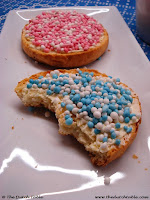I'm in such a happy mood! It's Spring, which is always a good reason to celebrate: new life, new births, new everything. I love seeing how the first flowers pop up in the garden, how the first leaves are carefully unfolding as if to check and see if winter is really over. It's a great time to celebrate life.
In Holland, the birth of a child is celebrated with beschuit, a twice-baked white roll that is as brittle and fragile as a new-born baby. Depending on the outcome, these rusks are buttered and sprinkled with pink muisjes if it's a girl, and blue muisjes if it's a boy. As it's usually either one or the other, only those two color variations exist for the sugar coated aniseed muisjes, or "mice". That is, unless you're royalty. In that case, the beschuit will be covered with orange muisjes, to represent the Dutch royal house, the Oranges.
Beschuit has been around since the early 1400s: the then bishop of Utrecht is said to already have enjoyed the twice-baked bread. During the 1600s, the city of Wormer made a name for itself with its beschuit, a finer table bread, and more delicate than its sturdier sister, the scheepsbeschuit or hardtack, that was produced for the seafaring population of that area. The popularity of both had, at one point, over 150 grain mills delivering the flour needed to produce all those beschuiten.
Nowadays, beschuit is still a favorite breakfast bread: it requires skill to butter the rusk without it breaking in three or four pieces and plenty of tourists have wondered why on earth the Dutch bother with something so dry and brittle if there are so many other breads to choose from.
But beschuit is one of those foods that triggers memories: softened with warm milk and sugar it becomes one of grandma's versions of lammetjespap (lambs porridge), crushed to fine crumbs it holds together that lovely schoenlapperstaart (cobbler's pie) or those famous Dutch meatballs, and if you were sick as a child, a cup of weak tea and a dry beschuit would sometimes be the only food you were allowed to eat.
Unfortunately beschuit is no longer baked by artesan bakers such as the ones in Wormer or Jisk, but large companies such as Verkade or Bolletje have included beschuit into their assortment of baked goods. Verkade started baking beschuit during the last part of the 19th century. Baking was considered a man's job but the beschuit was so brittle that Verkade started employing (unmarried) women to pack the rusks, as their hands were more slender and their packing skills more gentle than the burly beschuit bakers.
Making beschuit at home takes some time, but it's worth to do. You can vary with whole wheat flour, add sesame seeds or sprinkle cinnamon sugar on top for a sweet version. For the baking, use straight-edged ramekins that are five inches (approx. 12 cm) across and 1.5 inches (approx. 4 cm) high.
Beschuit
4 tablespoons (60 grams) butter, room temperature
4 tablespoons (50 grams) sugar

1 cup (250 ml) of milk
2 eggs
3 3/4 cups (450 grams) all-purpose flour
1 scant tablespoon (15 grams) baking powder
1 scant tablespoon (10 grams) active dry yeast
1 teaspoon of salt
Cream the butter and sugar. Mix the flour, baking powder, yeast, and salt in a bowl and add to the creamed butter. Add the milk and the eggs and knead everything into a pliable dough, for about five minutes.
Let it rest in an oiled bowl, covered for fifteen minutes, then divide into 3.5 ounces (100 grams) pieces. Roll and rest under a towel while you prepare the ramekins.
Preheat the oven to 350F/175C. Spray each ramekin with cooking spray. Place the dough balls on a baking sheet, cover each one with a ramekin and let the dough rise for about 30 minutes. Place the sheet on the middle rack and bake for twenty minutes, leaving the ramekins in place. Retrieve the baking sheet, remove the ramekins, turn the beschuit over and bake for another ten minutes.
Now, cool the beschuit until cold to the touch and slice the bread lengthwise in two. Place cut side up on the baking sheet and return the rusks to the oven, lowered to 325F/165C to dry and lightly brown.
This will take another ten to fifteen minutes, but keep an eye on the bread.
When they're golden and dry, remove, cool, and enjoy!! Makes approx. 7 beschuiten.














